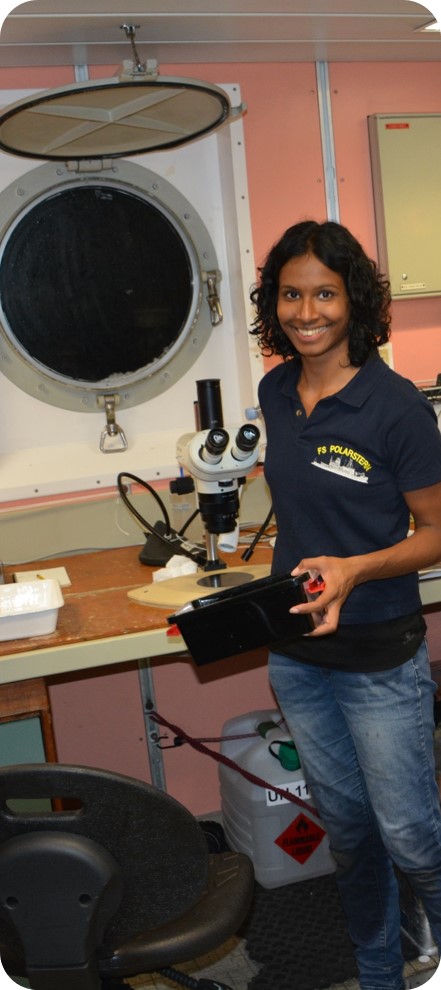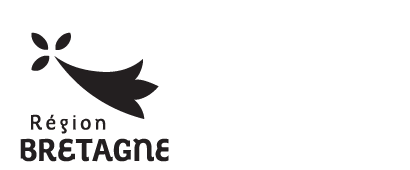Pavanee Annasawmy, oceanographer, studies the distribution of micronekton

Dr Pavanee Annasawmy is an oceanographer interested in the daily movement of micronekton, marine animals between 2 and 20cm in size. She started the FINZWIO project in January 2022 at LEMAR lab, in the University of Western Brittany.
[Team BIENVENÜE] Hello Pavanee, how did you become interested in your research topic?
[Dr Pavanee Annasawmy] I did a PhD in life and marine sciences in co-supervision between the University of Cape Town (South Africa) and the University of Montpellier. I was interested in the distribution of the micronekton near the seamounts in the southwestern Indian Ocean. Micronekton are an essential trophic link between zooplankton and top predators such as tuna, and are not yet widely fished by humans, who prefer their predators such as tuna. However, studies have begun to develop the fishing of micronekton for use as fishmeal, among other things.
Micronekton migrate at dawn and dusk, over distances between 300m and 1000m depth. They are present in deep cold waters during the day and come to the surface at nightfall. To observe this presence, I use an acoustic probe placed on a boat. It sends out an ultrasonic wave, which is reflected by the animal. So, I can know that there are animals in a certain place, but I don’t know what species they are. You then have to use a trawl net to fish and identify the animals with the help of taxonomists.
After my PhD, I worked with the Seychelles on heavy metal concentrations in micronekton, and then in the United States of America on crustaceans in the Antarctic Ocean. Using acoustic probes, I tried to characterise the flow of crustaceans at a given location, and tried to classify the passages of predators such as penguins, seals or whales.
What will you study in the FINZWIO project?
I am continuing my work on micronekton and zooplankton (20µm – 2 cm organisms) using more efficient acoustic tools. The LEMAR lab has recently acquired a new probe (AZFP – Acoustic Zooplankton and Fish Profiler) which allows to probe with different frequencies along vertical profiles. This will allow an even finer resolution of information (1-m vertically), particularly for zooplankton usually sampled by nets in large vertical strata. Other acoustic sounders (WBAT – Wideband Autonomous Transceiver) and EK80 will also be used to study organisms of all sizes (from macrozooplankton to top predators). These equipments have the advantage of giving access to the various frequency responses of the organisms, which are as much information to classify them (fish, crustaceans, gelatinous…). I will use acoustic data processing software developed by LEMAR to analyse these data and I aim to classify the acoustic responses to determine the types of organisms present in the water column.
I embark in April-May on board the Marion Dufresne to collect my data, during a multidisciplinary mission involving around fifty international scientists. For five weeks, we will leave Reunion Island for the south of Madagascar, and then sail up the Mozambique Channel to Durban (South Africa). I want to collect data to observe the dynamic distribution of zooplankton and micronekton in the Durban Gyre, a regular cyclone in this area. It is known that such an eddy concentrates a lot of life. I would like to understand when it concentrates the most life and whether it has an impact on the vertical distribution of zooplankton and micronekton.
How can climate change affect your research?
Climate change is affecting the formation of cyclones, but also the ‘sardine run’, a migration of whole shoals of sardines off South Africa. It is getting shorter, later in the year and moving less to the north. This has an impact on nearby inshore fisheries, as predators can no longer feed.
My data and results on zooplankton and micronekton will be used to feed other work and modelling on other animals but also to provide knowledge on the classification of species in relation to underwater currents.
Why did you choose the LEMAR laboratory to carry out this project?
The LEMAR lab is a major research unit in France in marine environmental sciences, very multidisciplinary, which is a great opportunity for a post-doc.
To carry out what is the disciplinary core of my project, I will be able to rely on LEMAR’s Acoustics Platform, the only one of its kind and a reference in France in the field of active acoustics applied to the study of marine ecosystems. This platform contributes to many scientific cruises worldwide and has the necessary skills and tools to carry out my research: state-of-the-art acoustic sounders and software to analyse the data.
Nevertheless, I will also take advantage of this cruise and the samples that will be taken to complete my work by carrying out research with other LEMAR researchers, in order to measure the concentration of heavy metals in the animals caught during the cruise.
Do you have a recommendation for a reader who is curious to go further on the subject?
I recommend the article “How do Scientists Use sound to count fish in the deep sea?” published by frontiers for Young Minds, a popular science magazine by and for children. The acoustic method is very well explained.
Thank you Pavanee !
